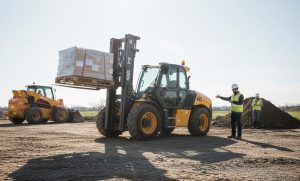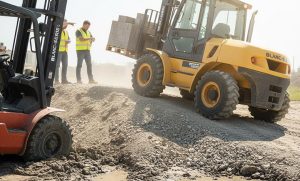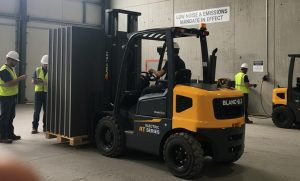I’ve lost count of how many times I’ve seen a construction site grind to a halt because the wrong forklift couldn’t handle the ground conditions.
[Rough terrain forklifts].[^1] are used on [construction sites][^2] to move heavy materials, climb slopes, and operate over mud, gravel, and uneven ground. They keep projects moving, even when standard forklifts can’t.
Let’s break down what really makes rough terrain forklifts indispensable in construction — and why they’ve quietly become the backbone of efficient job sites around the world.
What’s the real challenge on construction sites?
Most people think the problem is lifting heavy loads — but what really kills productivity is simply not being able to move when the ground turns rough.
[Rough terrain forklifts][^1] ensure [operational continuity][^3] by maintaining traction and mobility even on unpaved, uneven, or wet ground — preventing costly [downtime](https://www.blanc-ele.com/what-to-consider-when-buying-rough-terrain-forklifts-from-china/)[^4] and schedule delays.

In construction, time equals money. Every minute lost to mud or uneven access roads means idle labor and delayed deliveries. [Rough terrain forklifts][^1] solve this by combining high ground clearance, [4WD traction][^5], and deep-tread pneumatic tires. They aren’t just stronger — they’re consistent. A good machine doesn’t just lift; it keeps the jobsite alive.
| Problem | Standard Forklift | Rough Terrain Forklift |
|---|---|---|
| Traction | Low on soft or wet soil | Maintains full traction |
| Ground Clearance | 100–150 mm | 250–350 mm |
| Downtime Risk | High | Minimal |
| Operator Safety | Moderate | Enhanced with oscillating axles |
How can one forklift replace three machines?
When budgets are tight, the smartest contractors look for equipment that can do more with less.
A rough terrain forklift can replace multiple machines on site — handling lifting, loading, and transport in one unit, reducing costs and increasing efficiency.

On smaller job sites, you often see three separate machines: a telehandler for lifting, a skid steer for moving materials, and a forklift for unloading. But a modern 4WD forklift can handle all three tasks. It can unload materials from trucks, carry them across rough ground, and lift them to scaffolding height.
It’s not just a forklift — it’s a logistics tool that adapts to daily site chaos.
| Task Type | Traditional Equipment | Rough Terrain Forklift |
|---|---|---|
| Truck unloading | Standard forklift | ✅ Efficient |
| On-site transport | Skid steer / wheel loader | ✅ One machine |
| Lifting to height | Telehandler | ⚙️ Optional attachments |
| Maintenance cost | High (3 machines) | Low (1 machine) |
Why does downtime cost more than the forklift itself?
I’ve seen it firsthand — one broken forklift can shut down an entire site for hours, costing thousands in wasted labor.
Downtime on a construction site often costs more than the forklift itself. [Rough terrain forklifts][^1] minimize [downtime][^4] through durability, stronger frames, and reliable 4WD systems.

Think of [downtime][^4] as the silent thief of profit. While operators wait, wages, rent, and equipment costs continue ticking. That’s why investing in a rugged, low-maintenance forklift isn’t a luxury — it’s protection.
At BLANC-ELE, our RT Series forklifts use reinforced steel frames, wider wheelbases, and electronic hydraulic control systems designed for real-world punishment. They climb 15°–20° slopes, push through gravel, and just keep working.
For me, that’s not a sales pitch — it’s what keeps my clients’ schedules on track.
| Cost Source | Standard Forklift | Rough Terrain Forklift |
|---|---|---|
| Maintenance Frequency | High | Low |
| Daily Uptime | 80–85% | 95%+ |
| Labor Idle Time | Frequent | Minimal |
| ROI Cycle | 3–4 years | 2 years or less |
Is electric the future for construction forklifts?
More construction managers are realizing that power doesn’t have to mean diesel smoke anymore.
Electric rough terrain forklifts reduce noise, lower maintenance, and meet new emission standards — making them ideal for urban or enclosed construction projects.
Urban sites are getting stricter about emissions and noise. Traditional diesel machines face limits on night work and indoor operation. That’s why electric or hybrid 4WD forklifts are gaining ground. They deliver consistent torque, lower vibration, and much quieter operation — which means less operator fatigue.

At BLANC-ELE, we’ve seen growing demand for electric RT models — not just for sustainability, but because they’re practical. Quiet, efficient, and reliable even on tough ground.
| Feature | Diesel Rough Terrain | Electric Rough Terrain |
|---|---|---|
| Noise Level | High | Low |
| Emissions | CO₂ + NOx | Zero |
| Maintenance | Frequent (oil, filters) | Minimal |
| Torque Stability | Strong | Consistent |
Conclusion
On [construction sites][^2], rough terrain forklifts aren’t just tools — they’re insurance against lost time. They keep the project moving when everything else slows down.
—
[^1]: Explore how rough terrain forklifts enhance productivity and safety on challenging job sites.
[^2]: Learn about the unique challenges construction sites encounter and how to overcome them.
[^3]: Discover the importance of maintaining operational continuity in construction and how forklifts contribute.
[^4]: Understand the financial impact of downtime on construction projects and how to mitigate it.
[^5]: Learn how 4WD traction enhances performance and safety in challenging ground conditions.
